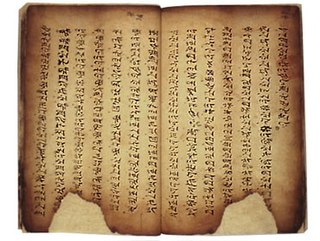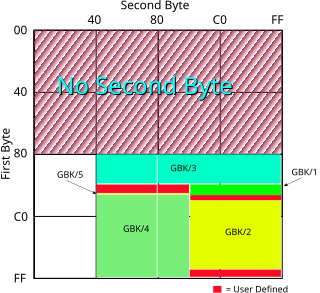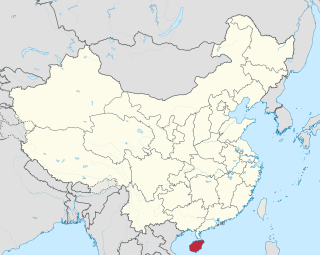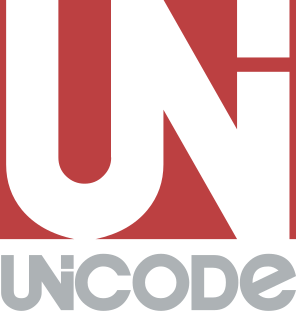
Mojibake is the garbled text that is the result of text being decoded using an unintended character encoding. The result is a systematic replacement of symbols with completely unrelated ones, often from a different writing system.
Han unification is an effort by the authors of Unicode and the Universal Character Set to map multiple character sets of the so-called CJK languages into a single set of unified characters. Han characters are a common feature of written Chinese (hanzi), Japanese (kanji), and Korean (hanja).

Simplified Chinese characters are standardized Chinese characters prescribed in the Table of General Standard Chinese Characters for use in mainland China. Along with traditional Chinese characters, they are one of the two standard character sets of the contemporary Chinese written language. The government of the People's Republic of China in mainland China has promoted them for use in printing since the 1950s and 1960s to encourage literacy. They are officially used in the People's Republic of China and Singapore.
In computing, Chinese character encodings can be used to represent text written in the CJK languages — Chinese, Japanese, Korean — and (rarely) obsolete Vietnamese, all of which use Chinese characters. Several general-purpose character encodings accommodate Chinese characters, and some of them were developed specifically for Chinese.
A double-byte character set (DBCS) is a character encoding in which either all characters are encoded in two bytes, or merely every graphic character not representable by an accompanying single-byte character set (SBCS) is encoded in two bytes. A DBCS supports national languages that contain a large number of unique characters or symbols. Examples of such languages include Japanese and Chinese. Korean Hangul does not contain as many characters, but KS X 1001 supports both Hangul and Hanja, and uses two bytes per character.
In computing, JIS encoding refers to several Japanese Industrial Standards for encoding the Japanese language. Strictly speaking, the term means either:

GB 18030 is a Chinese government standard, described as Information Technology — Chinese coded character set and defines the required language and character support necessary for software in China. GB18030 is the registered Internet name for the official character set of the People's Republic of China (PRC) superseding GB2312. As a Unicode Transformation Format, it is compatible with legacy encodings including GB2312, CP936, and GBK 1.0, GB18030 supports both simplified and traditional Chinese characters.
Extended Unix Code (EUC) is a multibyte character encoding system used primarily for Japanese, Korean, and simplified Chinese.
GB/T 2312-1980 is a key official character set of the People's Republic of China, used for simplified Chinese characters. GB2312 is the registered internet name for EUC-CN, which is its usual encoded form. GB abbreviates Guojia Biaozhun (国家标准), which means national standard in Chinese. GB2312 (1980) has been superseded by GBK and GB18030, which include additional characters, but GB2312 remains in widespread use as a subset of those encodings.
The Hong Kong Supplementary Character Set is a set of Chinese characters – 4,702 in total in the initial release—used in Cantonese, as well as when writing the names of some places in Hong Kong. It evolved from the preceding Government Chinese Character Set (政府通用字庫) or GCCS. GCCS is a set of supplementary Chinese characters coded in the user-defined areas of the Big5 character set. It was originally used within the Hong Kong Government and later used by the public. It later evolved into Hong Kong Supplementary Character Set when the characters in the set were submitted to ISO-10646 for coding.

The Yi script is an umbrella term for two scripts used to write the Yi languages; Classical Yi, and the later Yi Syllabary. The script is also historically known in Chinese as Cuan Wen or Wei Shu and various other names (夷字、倮語、倮倮文、畢摩文), among them "tadpole writing" (蝌蚪文).

GBK is an extension of the GB2312 character set for simplified Chinese characters, used in the People's Republic of China. It includes all unified CJK characters found in GB13000.1-93, i.e. ISO/IEC 10646:1993, or Unicode 1.1. Since its initial release in 1993, GBK has been extended by Microsoft in Code page 936/1386, which was then extended into GBK 1.0. GBK is also the IANA-registered internet name for the Microsoft mapping, which differs from other implementations primarily by the single-byte euro sign at 0x80.
The HZ character encoding is an encoding of GB2312 that was formerly commonly used in email and USENET postings. It was designed in 1989 by Fung Fung Lee of Stanford University, and subsequently codified in 1995 into RFC 1843.
The term internal code is a word-for-word translation of the Chinese term neima. The term is primarily used by Chinese people.
Windows Code page 936, is Microsoft's character encoding for simplified Chinese, one of the four DBCSs for East Asian languages. Originally, Windows-936 covered GB 2312, but it was expanded to cover most of GBK with the release of Windows 95.
The Chinese, Japanese and Korean (CJK) scripts share a common background, collectively known as CJK characters. In the process called Han unification, the common (shared) characters were identified and named CJK Unified Ideographs. As of Unicode 11.0, Unicode defines a total of 87,887 CJK Unified Ideographs.
The Sui language is a Kam–Sui language spoken by the Sui people of Guizhou province in China. According to Ethnologue, it was spoken by around 200,000 people in 1999. Sui is also unique for its rich inventory of consonants, with the Sandong (三洞) dialect having as many as 70 consonants. The language also has its own script, known as "Shuishu" (水書) in Chinese, which is used for ritual purposes.

Microsoft YaHei is a sans-serif gothic typeface created by Founder Electronics and Monotype Corporation under commission from Microsoft. Hinting for the font was undertaken by Monotype Imaging. The CJK ideographic characters were designed by the Founder Electronics foundry's senior designer, Li Qi (齐立).
Naming laws in the People's Republic of China are based on technical capability rather than the appropriateness of words. Although it is advised for parents to name their children so that others are able to easily read their names, there are no restrictions on the complexity of Chinese characters used, provided that there are no technical issues in doing so. The use of Simplified characters is advised over Traditional Chinese characters; however, this is not strictly enforced.












